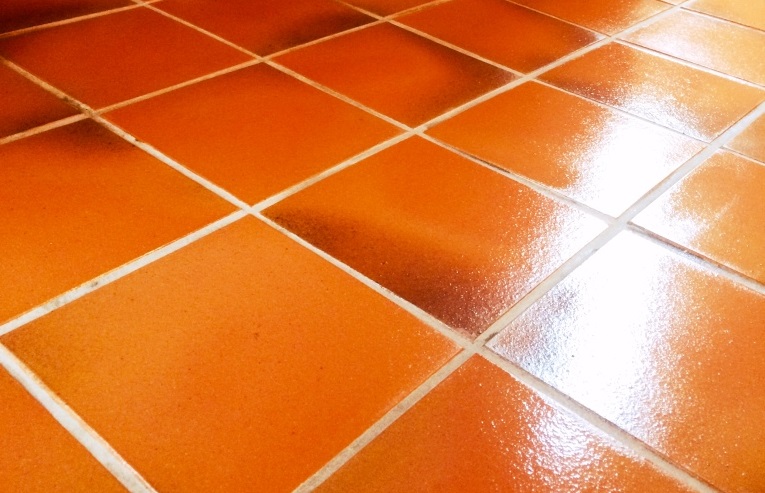Quarry tile

|
[edit] Introduction
Quarry tiles are a traditional flooring material used for both internal and external purposes. Being made of burnt clay, they are very durable, sometimes lasting many decades, with some varieties also being frost resistant. They come in a range of colours including red, brown, grey, purple and black. One of the most extensive external uses of quarry tiles in modern times was in the 1960s and 70s at the Barbican development in London.
Clay floor tiles have been used since Roman times, but fell out of favour during the Middle Ages. The most likely cause of this is that the techniques introduced by the Romans had been neglected or forgotten. However, the industrial revolution produced a revival of interest during Victorian times when alongside bricks, they were mass-produced for homes, churches and public buildings.
Today, they are considered a 'natural' material as they are made of burnt clay and used widely, particularly for hearths, conservatories and kitchens, where they can harmonise with both modern and traditional designs. As well as floors, they can also be used on walls and worktops. They are also used industrially.
Installation: Quarry tiles are usually bedded on a 10mm-thick bed of cement mortar spaced 9-10mm apart and with joints filled with cement grout. Wall junctions can be concealed with a cove tile for easier cleaning, while a range of special bullnose-edged tiles can be used for terminations, edges etc.
[edit] Manufacture
Quarry tiles are made in a process similar to that of brick, from either extruded or press-formed clay which is kiln-fired at temperatures as high as 2,000ºC. Their dimensions may vary but typically they are 150mm x 150mm (although larger sizes are available) and 13 to 19mm thick. They are unglazed and give good grip underfoot but can also be embedded with an abrasive frit to provide a non-slip finish for applications such as commercial kitchens and laboratories.
Because quarry tiles can be in place for decades, they may require a degree of renovation to restore them to an ‘almost new’ appearance. Cracked and missing tiles can be a problem but can usually be sourced to provide colour shades that are a close match with the original.
Dirty or faded tiles can be restored with alkaline cleaning compounds applied with a rotary floor machine, then rinsed off. A final clean may be applied with a light acid to remove any signs of efflorescence and counter the alkaline cleaner used in the first step. A matt sealing finish can then be applied. The advice of specialists should be sought when renovating quarry tiles.
[edit] Related articles on Designing Buildings Wiki
- Ash or oak wood flooring.
- Beam and block.
- BREEAM Speculative floor & ceiling finishes.
- Domestic floors: Part 1: Construction, insulation and damp proofing.
- Floating floor.
- Floor definition.
- Floor insulation.
- Flooring defects.
- Glass block flooring.
- How to fit carpet.
- Insulation for ground floors.
- Mastic sealant.
- Raised floor.
- Resin flooring.
- Screed.
- Sprung floor.
- Terrazzo.
- Tiles.
- Types of carpet.
- Types of floor.
Featured articles and news
RTPI leader to become new CIOB Chief Executive Officer
Dr Victoria Hills MRTPI, FICE to take over after Caroline Gumble’s departure.
Social and affordable housing, a long term plan for delivery
The “Delivering a Decade of Renewal for Social and Affordable Housing” strategy sets out future path.
A change to adoptive architecture
Effects of global weather warming on architectural detailing, material choice and human interaction.
The proposed publicly owned and backed subsidiary of Homes England, to facilitate new homes.
How big is the problem and what can we do to mitigate the effects?
Overheating guidance and tools for building designers
A number of cool guides to help with the heat.
The UK's Modern Industrial Strategy: A 10 year plan
Previous consultation criticism, current key elements and general support with some persisting reservations.
Building Safety Regulator reforms
New roles, new staff and a new fast track service pave the way for a single construction regulator.
Architectural Technologist CPDs and Communications
CIAT CPD… and how you can do it!
Cooling centres and cool spaces
Managing extreme heat in cities by directing the public to places for heat stress relief and water sources.
Winter gardens: A brief history and warm variations
Extending the season with glass in different forms and terms.
Restoring Great Yarmouth's Winter Gardens
Transforming one of the least sustainable constructions imaginable.
Construction Skills Mission Board launch sector drive
Newly formed government and industry collaboration set strategy for recruiting an additional 100,000 construction workers a year.
New Architects Code comes into effect in September 2025
ARB Architects Code of Conduct and Practice available with ongoing consultation regarding guidance.
Welsh Skills Body (Medr) launches ambitious plan
The new skills body brings together funding and regulation of tertiary education and research for the devolved nation.
Paul Gandy FCIOB announced as next CIOB President
Former Tilbury Douglas CEO takes helm.
UK Infrastructure: A 10 Year Strategy. In brief with reactions
With the National Infrastructure and Service Transformation Authority (NISTA).






















